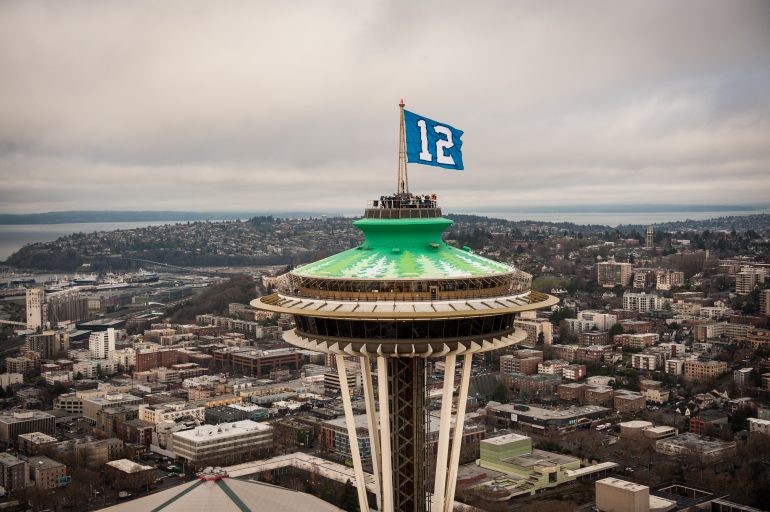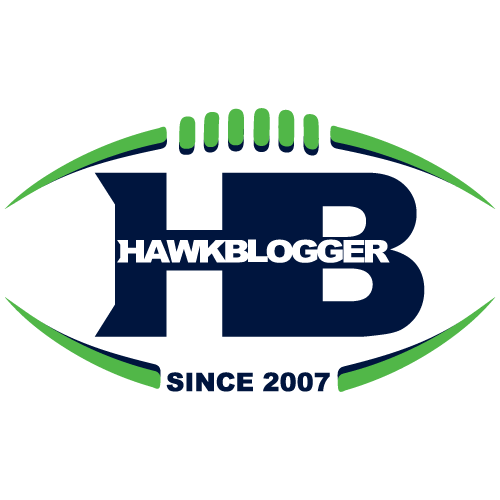Much can change throughout a season. Youthful mistakes can turn into veteran moxy. Weakness can turn into strength. Pete Carroll and the coaching staff is relying on time to elevate an offensive line that, as it stands, is not good enough to allow the Seahawks to contend for a Super Bowl. It is a self-imposed obstacle. They say hindsight is 20/20, but let’s explore the choices that led here to see if we would make the same decision if had it to do over again.
The 2013 championship offensive line
Most people forget that the Seahawks had a disastrous offensive line for much of their 13-3 Super Bowl season. Russell Okung and Breno Giacomini were injured for a large stretch, forcing Paul McQuistan to play the worst brand of left tackle in the league, and then-rookie Michael Bowie to start at right tackle. James Carpenter and J.R. Sweezy were a mess at guard, and even Max Unger had a down year. Alvin Bailey had a strong rookie season, including a great performance in the NFC Championship against a dominating 49ers defense that is still the best Seattle has played against.
Blocking duties go beyond the offensive line in Tom Cable’s world, and the Seahawks were well equipped there as Zach Miller was a terrific blocking tight end and FB Michael Robinson was an ace in pass protection and run blocking. That group, as a whole, was tough, flexible and gritty as hell.
Deconstruction begins (2014)
Robinson retired after the season, and Giacomini departed via free agency. The Jets signed him to a 4 year contract worth $18M, with $7M in guarantees. Letting him walk seemed like a logical decision at the time given that Bowie had started most of the season and had a very promising year, and Bailey could play tackle as well. The team then spent a second round pick on Justin Britt to give them a pile of potential to replace a player in Giacomini who was just a bit above average.
The real problem started when Bowie reported to camp overweight and quickly injured himself. The presumptive starter at right tackle, who PFF had as the highest rated run blocker on the Seahawks 2013 offensive line, never played another snap for the Seahawks as he was waived with an injury designation and the Cleveland Browns scooped him up off waivers. Don’t spend much time wondering about what could have been. Bowie is on IR for the second straight season for the Browns.
Bowie’s injury elevated Britt to the starting role by default. While Giacomini was never a world beater, Britt represented a major step backwards in pass protection. He was the worst right tackle in the NFL last year, per PFF, and his pass blocking was the reason. Giacomini checked in as the 43rd ranked pass blocker at tackle with a -1.4 rating. Britt ranked 81st, and had a dismal -17.6 pass block rating.
To make matters worse, Miller got injured early on. He was a key cog in Cable’s blocking schemes, and often was asked to help the right tackle in pass blocking. Miller was the second-best run blocker on the championship team with a +7.7 run block rating. Another complicating factor was the season-ending injury to Derrick Coleman, leaving the team playing running back Robert Turbin at fullback for a few games before turning to Will Tukuafu.
Unger was injured for much of the season, and his backups—Lemuel Jeanpierre and Patrick Lewis—struggled, especially as pass blockers. Still, Unger was easily the best lineman on the team when he was in the game, and he managed to be healthy for the playoffs. It is hard to imagine the Seahawks making it back to their second straight Super Bowl without him.
The Super Bowl appearance masked some serious cracks in the foundation. Scoring dropped a couple of points from the year before. Russell Wilson saw his passer rating (95.0) drop below 100.0 for the first time in his career, and his passing touchdowns total (20) was significantly lower than his first two years (26 in each). His rushing yards exploded, adding 300 yards to his previous high, but that’s not necessarily a good thing.
Clearing the decks (2015)
As challenged as the 2014 offensive line was, they managed to hold it together well enough to allow Seattle to compete for a second straight ring. More players left after the season. James Carpenter joined Giacomini in New York, signing a 4 year deal worth $19.1M with $5M guaranteed. Carpenter was always a controversial figure amongst Seahawks fans who felt he was overdrafted in the first round back in 2011 and flamed out early on at right tackle.
He battled injuries at the start of his career, but was a reliable starter for the Seahawks in 2014. Some might be surprised to know that he was the second-highest rated pass blocker on the team last season, according to PFF. Neither Carpenter nor Giacomini have Pro Bowl talent, but Carpenter would be the highest rated guard on this current Seahawks team and Giacomini would be the highest rated pass blocker at tackle, per PFF. Throw in Unger rating far better than Drew Nowak, and it is easy to see the disparity between this line and what Seattle won with in the past.
Unger was, of course, traded along with a first round pick, for Jimmy Graham. Miller was cut and appears to have retired.
Realistic alternatives
Many of you know I came out strongly against the trade of Unger for Graham. In general, I abhor trading core lineman on either side of the ball for skill players. At the time, I also questioned whether Graham had any place in a Seahawks locker room defined by grit and genuine toughness. He quickly dispelled the second question, but the first remains.
Would you trade Jimmy Graham for Max Unger straight up right now? The vast majority of you are shaking your heads right now. That is probably the correct reaction. Let’s make it a little harder.
Imagine that the Graham trade was never made. Seattle has Unger back, along with their first round pick. Now, let’s play it forward assuming the Seahawks still wanted to add a dynamic pass catcher at tight end. Consider that Jordan Cameron was available for 2 years and $15M and $5M guaranteed. He has 10 catches for 151 yards so far this season for the Dolphins. Graham has 14 catches for 145 yards. Cameron also checks in with a 95% pass blocking efficiency (30th among TEs), while Graham is dead last (43rd) with a 78% rate.
Cameron’s cap number this year is $4.5M. Graham is at $8M. Assume that Unger agreed to restructure his deal the same way he did for the Saints, converting $3M of his 2015 salary to a signing bonus to lower his total 2015 cap hit to $3M. You are still under the cost of Graham. But you still have that first round pick to consider.
The Saints drafted Stephone Anthony with the Seahawks 31st pick in the first. He signed a four year deal worth $7.7M and a 2015 cap number of $1.4M. John Schneider almost certainly would have tried to trade out of the first round. The Seahawks front office loved C Mitch Morse. They probably would have picked him in the first if they could not trade back, but even if they had traded back with a team like the Saints, the still could have nabbed him before the Chiefs selected him 49th overall.
Depending on where the Seahawks took Morse, their cap cost for him, Unger and Cameron would be somewhere between $500K-$1M more than Graham’s total cost is for 2015. They could have made up for that by finding a cheaper option at cornerback than Cary Williams ($4.6M cap number in 2015). Two options that pop to the top of that list would have been Brandon Browner ($2.4M cap number) and Walter Thurmond ($3.2M cap number). Going with a player like Browner would have left some room for an additional move.
Anthony Fasano was high on my Seahawks free agent big board because he is a solid blocker, a reliable receiver and affordable. He signed a 2 year deal worth $5.2M with the Titans, and has a $2M cap number this season. He is currently the 3rd ranked tight end, overall, in PFF with a grade of +3.9. Most of that is coming from a +3.0 grade as a run blocker. He would replace Cooper Helfet on the roster who has a $500K cap number.
What you end up with is Unger as your starting center, Morse likely starting at left guard this year before replacing Unger at center in the future, and a tight end group of Cameron, Luke Willson and Fasano. Right tackle would be manned by either Britt, Garry Gilliam or Alvin Bailey and still be a problem. The difference would be Fasano would be in tow to help out. If Cable is going to keep asking tight ends to block defensive ends, the team needs to take the blocking tight end role more seriously. Morse is currently the 7th highest rated center, per PFF, and is solid both as a run and pass blocker.
Graham is an elite talent that eclipses any of the players listed there. Losing him would definitely take some of the ceiling off the potential of the offense. It is hard to build a skyscraper, though, on a cracked foundation. The line is barely holding things together. Given the choice, I would prefer having Unger and Morse in the mix, and would take my chances with Cameron and Fasano doing enough to make the team better overall.
Back to reality
That is not the way things went. Seattle has an all-world tight end. They also have three players in their first years at their positions on the offensive line. There have been promising moments, like the pass blocking in the game against the Packers and the run blocking in the game against the Bears. The next step is to do one or the other two weeks in a row. Then, do both in one game. It will be a process, and that path will almost certainly take us through valleys. The unknown is whether there is a peak ahead. This could just be a line with limited talent that will never be much more than we see right now. It is also possible that they become the most improved part of this team. Only time and tests will reveal the truth.
One lesson that I hope Seattle has learned through this process is that their evaluation process for offensive lineman needs to be overhauled. Since Cable joined the team, they have added these lineman:
- Robert Gallery
- James Carpenter
- John Moffit
- Paul McQuistan
- Justin Britt
- Alvin Bailey
- Garry Gilliam
- J.R. Sweezy
- Mark Glowinksi
- Terry Poole
- Kristjan Sokoli
- Drew Nowak
- Patrick Lewis
I respect Cable’s ability to make chicken salad out of chicken $!%*, but it is okay to put a filet on the menu once-in-a-while. To lay it all at Cable’s feet would be unfair. You can be sure he would have likely prioritized keeping players like Giacomini, Carpenter and Unger which would make this line look quite different. Schneider rightly has tried to save some money there to bolster the team elsewhere. His trade of Unger for Graham may have been more than his offensive line coach could repair.
A team that prides itself on running the football needs to invest more in the lineman who clear the path. With Russell Okung and J.R. Sweezy both scheduled to hit the free agent market next year, this could get a whole lot worse if the Seahawks do not turn this demolition project into a renovation.



